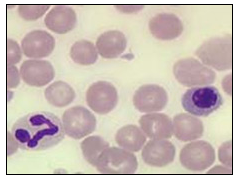Archival Notice
This is an archive page that is no longer being updated. It may contain outdated information and links may no longer function as originally intended.
Home | Glossary | Resources | Help | Contact Us | Course Map
Blood is a suspension of cells in an aqueous solution, consisting of three types of materials:
- salts (sodium, potassium, and chloride ions)
- organic chemicals (glucose, hormones, and vitamins)
- proteins
There are three cellular components to blood:
- red blood cells (RBCs) or erythrocytes
- platelets or thrombocytes
- white blood cells (WBCs) or leukocytes
The cellular component of blood is mainly comprised of red blood cells, which account for about 45% of the total volume and is referred to as the hematocrit. RBCs are unique because the mature circulating cells contain no DNA. Their function is to transport oxygen to tissues as a hemoglobin complex.
White blood cells, which possess a nucleus (and therefore DNA), are involved in the body's responses to infection. Lymphocytes, one type of WBCs, are responsible for antibody production.
The fluid portion of unclotted blood is called plasma. Blood clots through the conversion of a dissolved protein, fibrinogen, to a precipitated polymer, fibrin. Fibrin traps platelets to form the clot. The liquid fraction obtained from clotted blood is called serum. Serum can be further separated into fractions by electrophoresis. The simple and not very discriminating forms of electrophoresis that were first used, such as those employing cellulose acetate membranes, typically produced only four fractions. These are, in order of electrophoretic mobility, albumin, followed by three globulin fractions designated as alpha, beta, and gamma. These designations have become accepted terms used to describe serum proteins.
About half of the serum consists of albumin, which is one of the factors that preserves blood volume by regulating osmotic pressure. In contrast, each globulin fraction consists of many different proteins. This is particularly true of the gamma globulin fraction, which contains antibodies.
Additional Online Courses
- What Every First Responding Officer Should Know About DNA Evidence
- Collecting DNA Evidence at Property Crime Scenes
- DNA – A Prosecutor’s Practice Notebook
- Crime Scene and DNA Basics
- Laboratory Safety Programs
- DNA Amplification
- Population Genetics and Statistics
- Non-STR DNA Markers: SNPs, Y-STRs, LCN and mtDNA
- Firearms Examiner Training
- Forensic DNA Education for Law Enforcement Decisionmakers
- What Every Investigator and Evidence Technician Should Know About DNA Evidence
- Principles of Forensic DNA for Officers of the Court
- Law 101: Legal Guide for the Forensic Expert
- Laboratory Orientation and Testing of Body Fluids and Tissues
- DNA Extraction and Quantitation
- STR Data Analysis and Interpretation
- Communication Skills, Report Writing, and Courtroom Testimony
- Español for Law Enforcement
- Amplified DNA Product Separation for Forensic Analysts


